Economics For Business And Management
VerifiedAdded on 2022/09/14
|12
|2690
|13
AI Summary
Contribute Materials
Your contribution can guide someone’s learning journey. Share your
documents today.
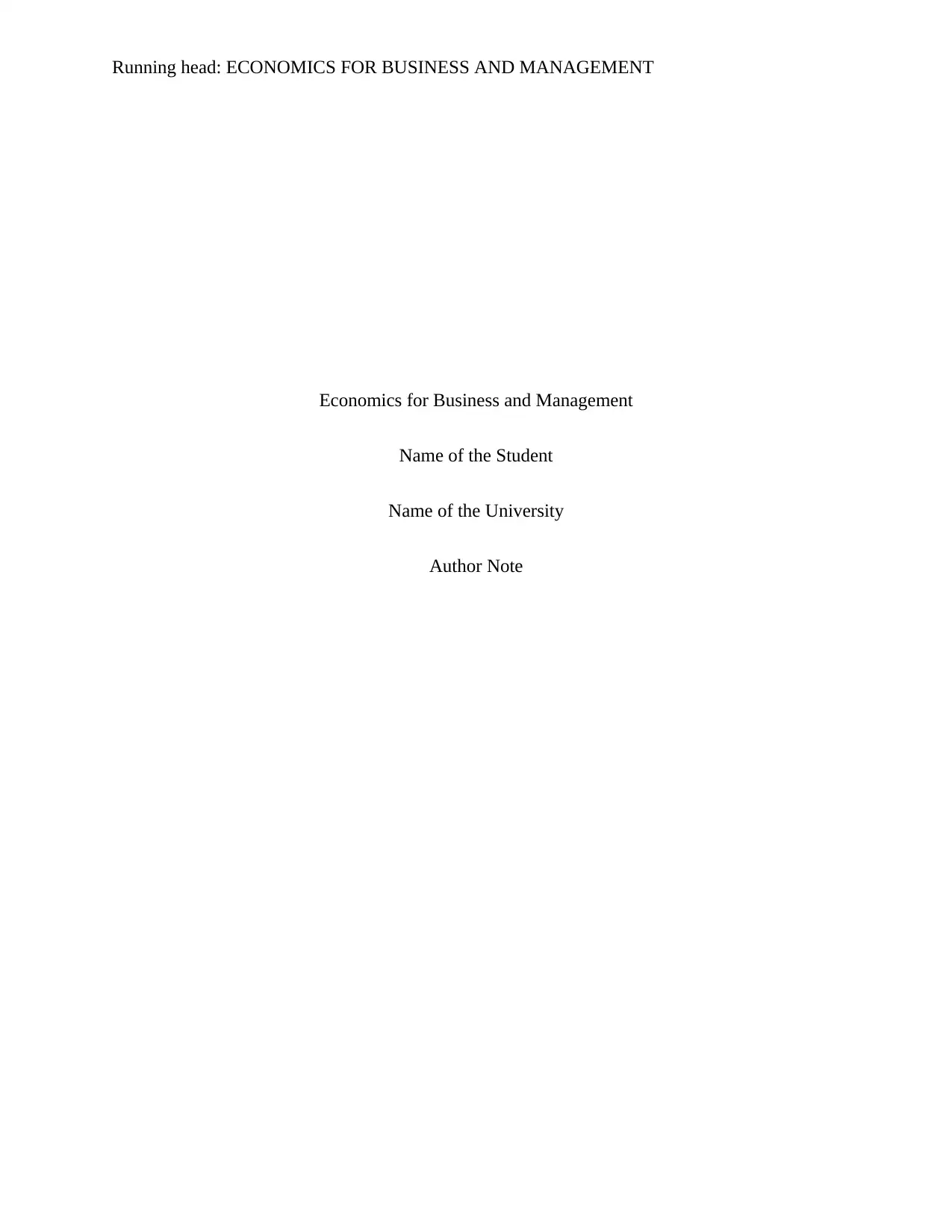
Running head: ECONOMICS FOR BUSINESS AND MANAGEMENT
Economics for Business and Management
Name of the Student
Name of the University
Author Note
Economics for Business and Management
Name of the Student
Name of the University
Author Note
Secure Best Marks with AI Grader
Need help grading? Try our AI Grader for instant feedback on your assignments.
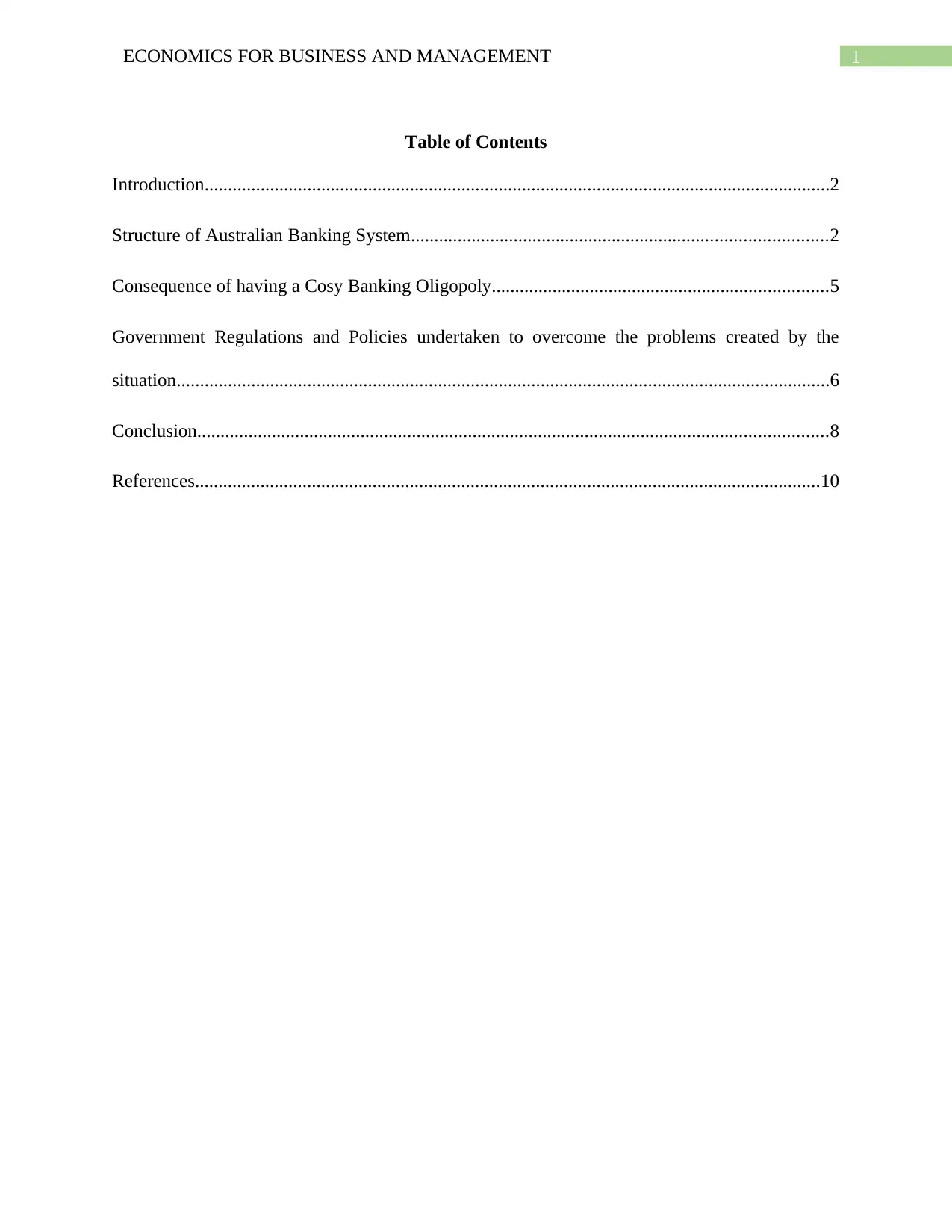
1ECONOMICS FOR BUSINESS AND MANAGEMENT
Table of Contents
Introduction......................................................................................................................................2
Structure of Australian Banking System.........................................................................................2
Consequence of having a Cosy Banking Oligopoly........................................................................5
Government Regulations and Policies undertaken to overcome the problems created by the
situation............................................................................................................................................6
Conclusion.......................................................................................................................................8
References......................................................................................................................................10
Table of Contents
Introduction......................................................................................................................................2
Structure of Australian Banking System.........................................................................................2
Consequence of having a Cosy Banking Oligopoly........................................................................5
Government Regulations and Policies undertaken to overcome the problems created by the
situation............................................................................................................................................6
Conclusion.......................................................................................................................................8
References......................................................................................................................................10
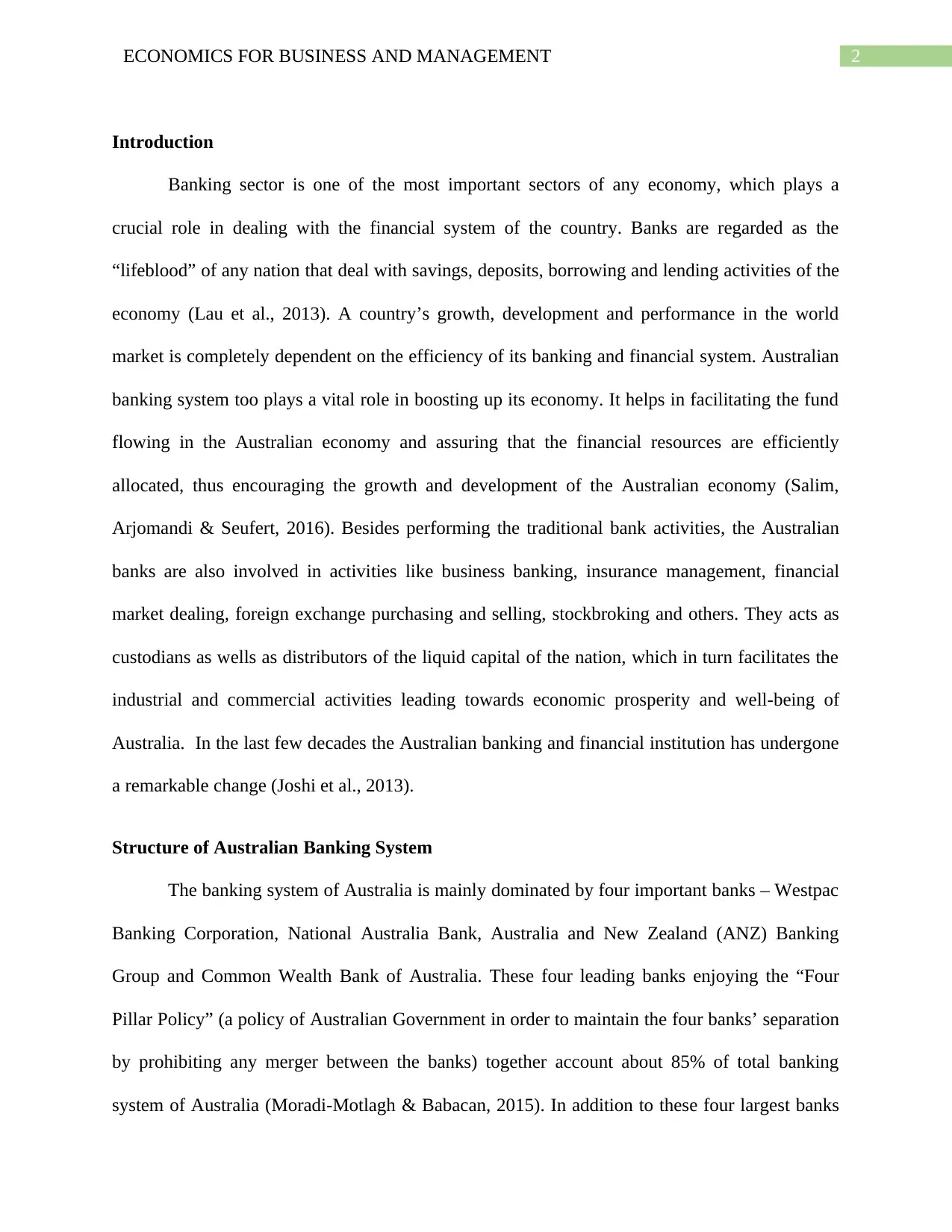
2ECONOMICS FOR BUSINESS AND MANAGEMENT
Introduction
Banking sector is one of the most important sectors of any economy, which plays a
crucial role in dealing with the financial system of the country. Banks are regarded as the
“lifeblood” of any nation that deal with savings, deposits, borrowing and lending activities of the
economy (Lau et al., 2013). A country’s growth, development and performance in the world
market is completely dependent on the efficiency of its banking and financial system. Australian
banking system too plays a vital role in boosting up its economy. It helps in facilitating the fund
flowing in the Australian economy and assuring that the financial resources are efficiently
allocated, thus encouraging the growth and development of the Australian economy (Salim,
Arjomandi & Seufert, 2016). Besides performing the traditional bank activities, the Australian
banks are also involved in activities like business banking, insurance management, financial
market dealing, foreign exchange purchasing and selling, stockbroking and others. They acts as
custodians as wells as distributors of the liquid capital of the nation, which in turn facilitates the
industrial and commercial activities leading towards economic prosperity and well-being of
Australia. In the last few decades the Australian banking and financial institution has undergone
a remarkable change (Joshi et al., 2013).
Structure of Australian Banking System
The banking system of Australia is mainly dominated by four important banks – Westpac
Banking Corporation, National Australia Bank, Australia and New Zealand (ANZ) Banking
Group and Common Wealth Bank of Australia. These four leading banks enjoying the “Four
Pillar Policy” (a policy of Australian Government in order to maintain the four banks’ separation
by prohibiting any merger between the banks) together account about 85% of total banking
system of Australia (Moradi-Motlagh & Babacan, 2015). In addition to these four largest banks
Introduction
Banking sector is one of the most important sectors of any economy, which plays a
crucial role in dealing with the financial system of the country. Banks are regarded as the
“lifeblood” of any nation that deal with savings, deposits, borrowing and lending activities of the
economy (Lau et al., 2013). A country’s growth, development and performance in the world
market is completely dependent on the efficiency of its banking and financial system. Australian
banking system too plays a vital role in boosting up its economy. It helps in facilitating the fund
flowing in the Australian economy and assuring that the financial resources are efficiently
allocated, thus encouraging the growth and development of the Australian economy (Salim,
Arjomandi & Seufert, 2016). Besides performing the traditional bank activities, the Australian
banks are also involved in activities like business banking, insurance management, financial
market dealing, foreign exchange purchasing and selling, stockbroking and others. They acts as
custodians as wells as distributors of the liquid capital of the nation, which in turn facilitates the
industrial and commercial activities leading towards economic prosperity and well-being of
Australia. In the last few decades the Australian banking and financial institution has undergone
a remarkable change (Joshi et al., 2013).
Structure of Australian Banking System
The banking system of Australia is mainly dominated by four important banks – Westpac
Banking Corporation, National Australia Bank, Australia and New Zealand (ANZ) Banking
Group and Common Wealth Bank of Australia. These four leading banks enjoying the “Four
Pillar Policy” (a policy of Australian Government in order to maintain the four banks’ separation
by prohibiting any merger between the banks) together account about 85% of total banking
system of Australia (Moradi-Motlagh & Babacan, 2015). In addition to these four largest banks

3ECONOMICS FOR BUSINESS AND MANAGEMENT
of the country, there exist a number of small banks which have nation-wide prevalence and
several financial institutions like mutual banks, credit unions and building societies, providing
limited banking-type facilities, known as Authorized Deposit-taking Institutions (ADIs).
Recently, fifty-three (53) banks are operating in the country, among them fourteen (14) banks are
predominantly owned by the country. The Reserve Bank of Australia (RBA) is the central bank,
which provides services to the Australian Government along with various official institutions and
central banks.
Table 1: Share of Deposits
Source: Twigg, 2018
A market is referred to as an oligopoly market when there are few firms dominating the
entire market (Fudenberg & Tirole, 2013). An oligopoly market is characterized by
interdependence, entry barrier and prevalence of imperfect information among the customers
(Waldman & Jensen, 2016). From the Australian banking structure as discussed above, it is clear
that the four big banks, Westpac Banking Corporation, National Australia Bank, Australia and
New Zealand (ANZ) Banking Group and Common Wealth Bank of Australia, dominate the
of the country, there exist a number of small banks which have nation-wide prevalence and
several financial institutions like mutual banks, credit unions and building societies, providing
limited banking-type facilities, known as Authorized Deposit-taking Institutions (ADIs).
Recently, fifty-three (53) banks are operating in the country, among them fourteen (14) banks are
predominantly owned by the country. The Reserve Bank of Australia (RBA) is the central bank,
which provides services to the Australian Government along with various official institutions and
central banks.
Table 1: Share of Deposits
Source: Twigg, 2018
A market is referred to as an oligopoly market when there are few firms dominating the
entire market (Fudenberg & Tirole, 2013). An oligopoly market is characterized by
interdependence, entry barrier and prevalence of imperfect information among the customers
(Waldman & Jensen, 2016). From the Australian banking structure as discussed above, it is clear
that the four big banks, Westpac Banking Corporation, National Australia Bank, Australia and
New Zealand (ANZ) Banking Group and Common Wealth Bank of Australia, dominate the
Secure Best Marks with AI Grader
Need help grading? Try our AI Grader for instant feedback on your assignments.
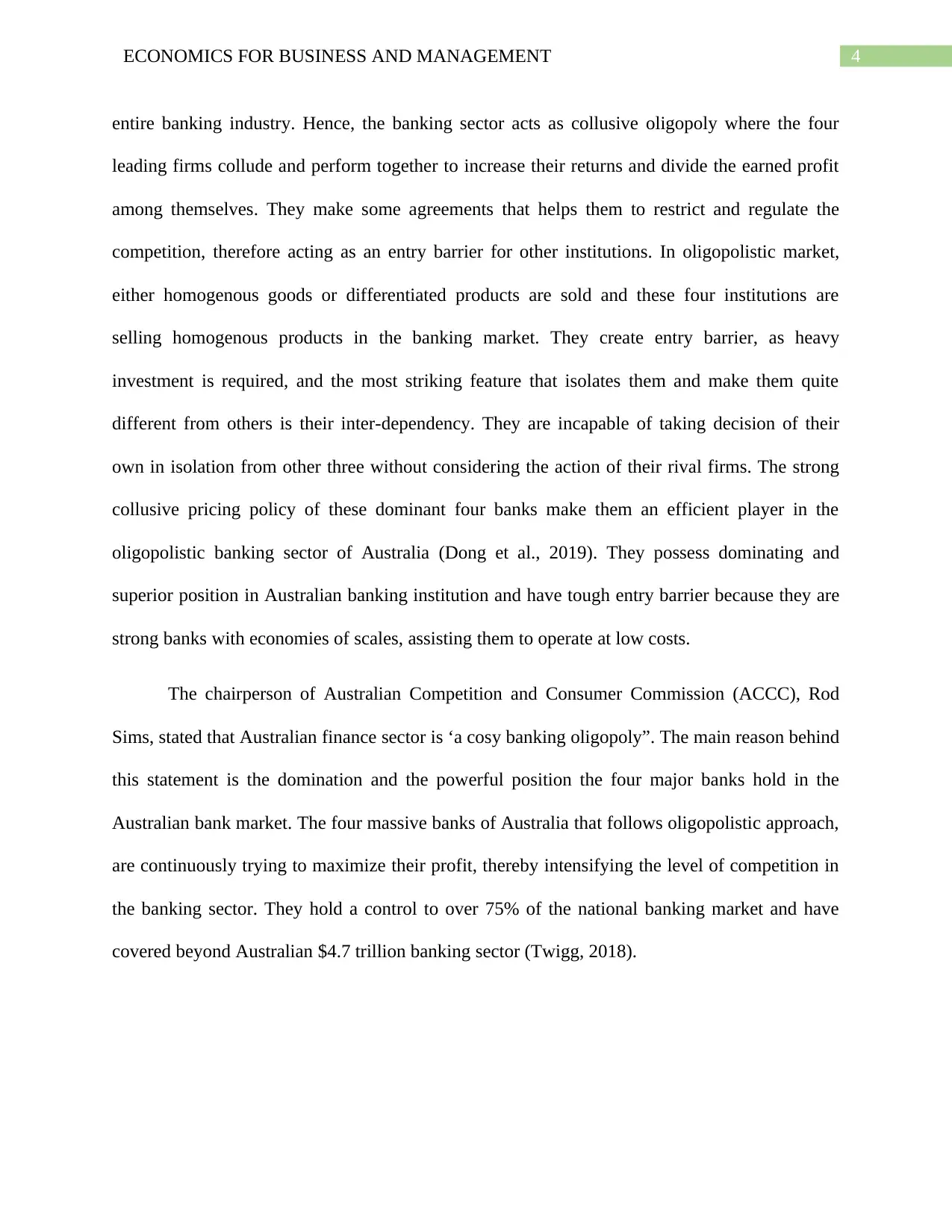
4ECONOMICS FOR BUSINESS AND MANAGEMENT
entire banking industry. Hence, the banking sector acts as collusive oligopoly where the four
leading firms collude and perform together to increase their returns and divide the earned profit
among themselves. They make some agreements that helps them to restrict and regulate the
competition, therefore acting as an entry barrier for other institutions. In oligopolistic market,
either homogenous goods or differentiated products are sold and these four institutions are
selling homogenous products in the banking market. They create entry barrier, as heavy
investment is required, and the most striking feature that isolates them and make them quite
different from others is their inter-dependency. They are incapable of taking decision of their
own in isolation from other three without considering the action of their rival firms. The strong
collusive pricing policy of these dominant four banks make them an efficient player in the
oligopolistic banking sector of Australia (Dong et al., 2019). They possess dominating and
superior position in Australian banking institution and have tough entry barrier because they are
strong banks with economies of scales, assisting them to operate at low costs.
The chairperson of Australian Competition and Consumer Commission (ACCC), Rod
Sims, stated that Australian finance sector is ‘a cosy banking oligopoly”. The main reason behind
this statement is the domination and the powerful position the four major banks hold in the
Australian bank market. The four massive banks of Australia that follows oligopolistic approach,
are continuously trying to maximize their profit, thereby intensifying the level of competition in
the banking sector. They hold a control to over 75% of the national banking market and have
covered beyond Australian $4.7 trillion banking sector (Twigg, 2018).
entire banking industry. Hence, the banking sector acts as collusive oligopoly where the four
leading firms collude and perform together to increase their returns and divide the earned profit
among themselves. They make some agreements that helps them to restrict and regulate the
competition, therefore acting as an entry barrier for other institutions. In oligopolistic market,
either homogenous goods or differentiated products are sold and these four institutions are
selling homogenous products in the banking market. They create entry barrier, as heavy
investment is required, and the most striking feature that isolates them and make them quite
different from others is their inter-dependency. They are incapable of taking decision of their
own in isolation from other three without considering the action of their rival firms. The strong
collusive pricing policy of these dominant four banks make them an efficient player in the
oligopolistic banking sector of Australia (Dong et al., 2019). They possess dominating and
superior position in Australian banking institution and have tough entry barrier because they are
strong banks with economies of scales, assisting them to operate at low costs.
The chairperson of Australian Competition and Consumer Commission (ACCC), Rod
Sims, stated that Australian finance sector is ‘a cosy banking oligopoly”. The main reason behind
this statement is the domination and the powerful position the four major banks hold in the
Australian bank market. The four massive banks of Australia that follows oligopolistic approach,
are continuously trying to maximize their profit, thereby intensifying the level of competition in
the banking sector. They hold a control to over 75% of the national banking market and have
covered beyond Australian $4.7 trillion banking sector (Twigg, 2018).
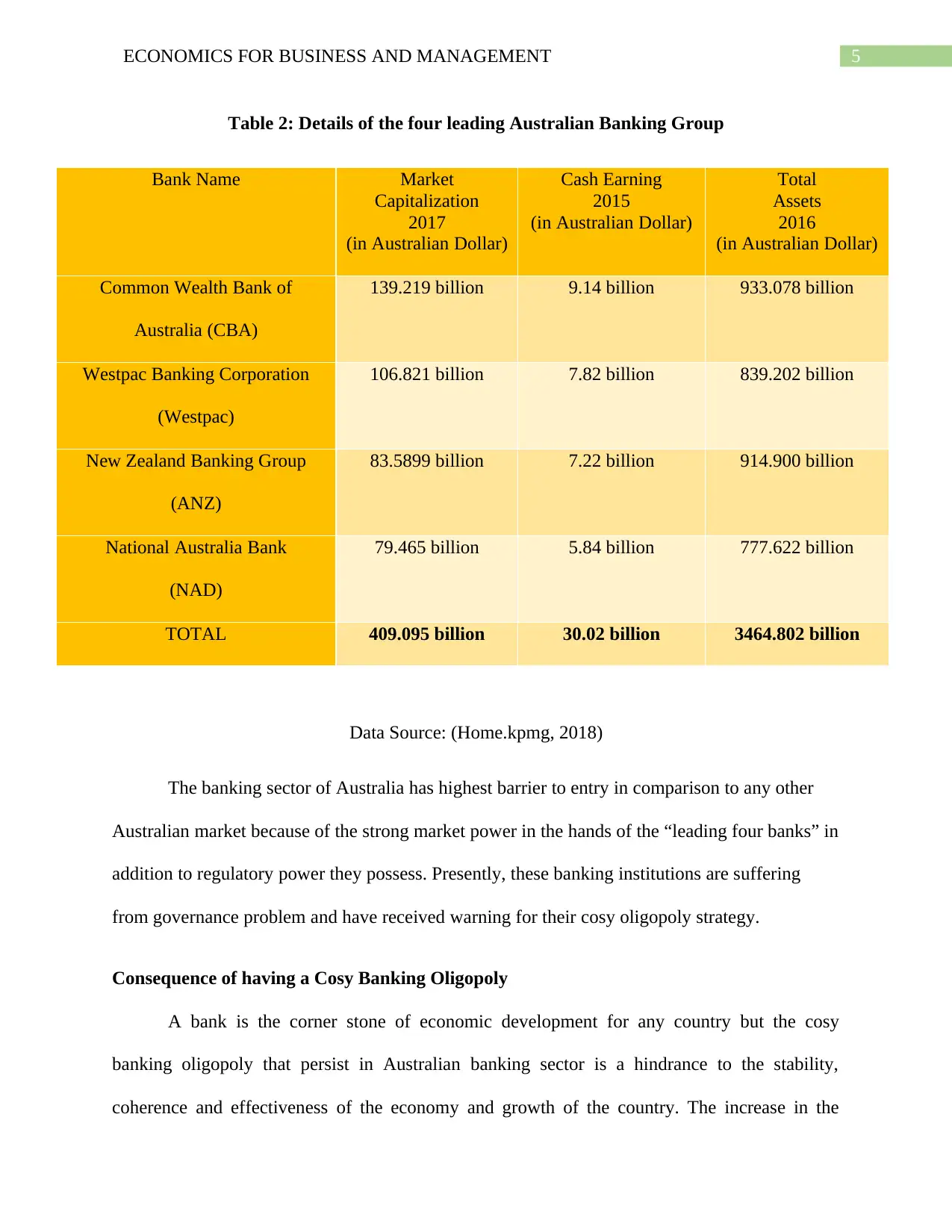
5ECONOMICS FOR BUSINESS AND MANAGEMENT
Table 2: Details of the four leading Australian Banking Group
Bank Name Market
Capitalization
2017
(in Australian Dollar)
Cash Earning
2015
(in Australian Dollar)
Total
Assets
2016
(in Australian Dollar)
Common Wealth Bank of
Australia (CBA)
139.219 billion 9.14 billion 933.078 billion
Westpac Banking Corporation
(Westpac)
106.821 billion 7.82 billion 839.202 billion
New Zealand Banking Group
(ANZ)
83.5899 billion 7.22 billion 914.900 billion
National Australia Bank
(NAD)
79.465 billion 5.84 billion 777.622 billion
TOTAL 409.095 billion 30.02 billion 3464.802 billion
Data Source: (Home.kpmg, 2018)
The banking sector of Australia has highest barrier to entry in comparison to any other
Australian market because of the strong market power in the hands of the “leading four banks” in
addition to regulatory power they possess. Presently, these banking institutions are suffering
from governance problem and have received warning for their cosy oligopoly strategy.
Consequence of having a Cosy Banking Oligopoly
A bank is the corner stone of economic development for any country but the cosy
banking oligopoly that persist in Australian banking sector is a hindrance to the stability,
coherence and effectiveness of the economy and growth of the country. The increase in the
Table 2: Details of the four leading Australian Banking Group
Bank Name Market
Capitalization
2017
(in Australian Dollar)
Cash Earning
2015
(in Australian Dollar)
Total
Assets
2016
(in Australian Dollar)
Common Wealth Bank of
Australia (CBA)
139.219 billion 9.14 billion 933.078 billion
Westpac Banking Corporation
(Westpac)
106.821 billion 7.82 billion 839.202 billion
New Zealand Banking Group
(ANZ)
83.5899 billion 7.22 billion 914.900 billion
National Australia Bank
(NAD)
79.465 billion 5.84 billion 777.622 billion
TOTAL 409.095 billion 30.02 billion 3464.802 billion
Data Source: (Home.kpmg, 2018)
The banking sector of Australia has highest barrier to entry in comparison to any other
Australian market because of the strong market power in the hands of the “leading four banks” in
addition to regulatory power they possess. Presently, these banking institutions are suffering
from governance problem and have received warning for their cosy oligopoly strategy.
Consequence of having a Cosy Banking Oligopoly
A bank is the corner stone of economic development for any country but the cosy
banking oligopoly that persist in Australian banking sector is a hindrance to the stability,
coherence and effectiveness of the economy and growth of the country. The increase in the
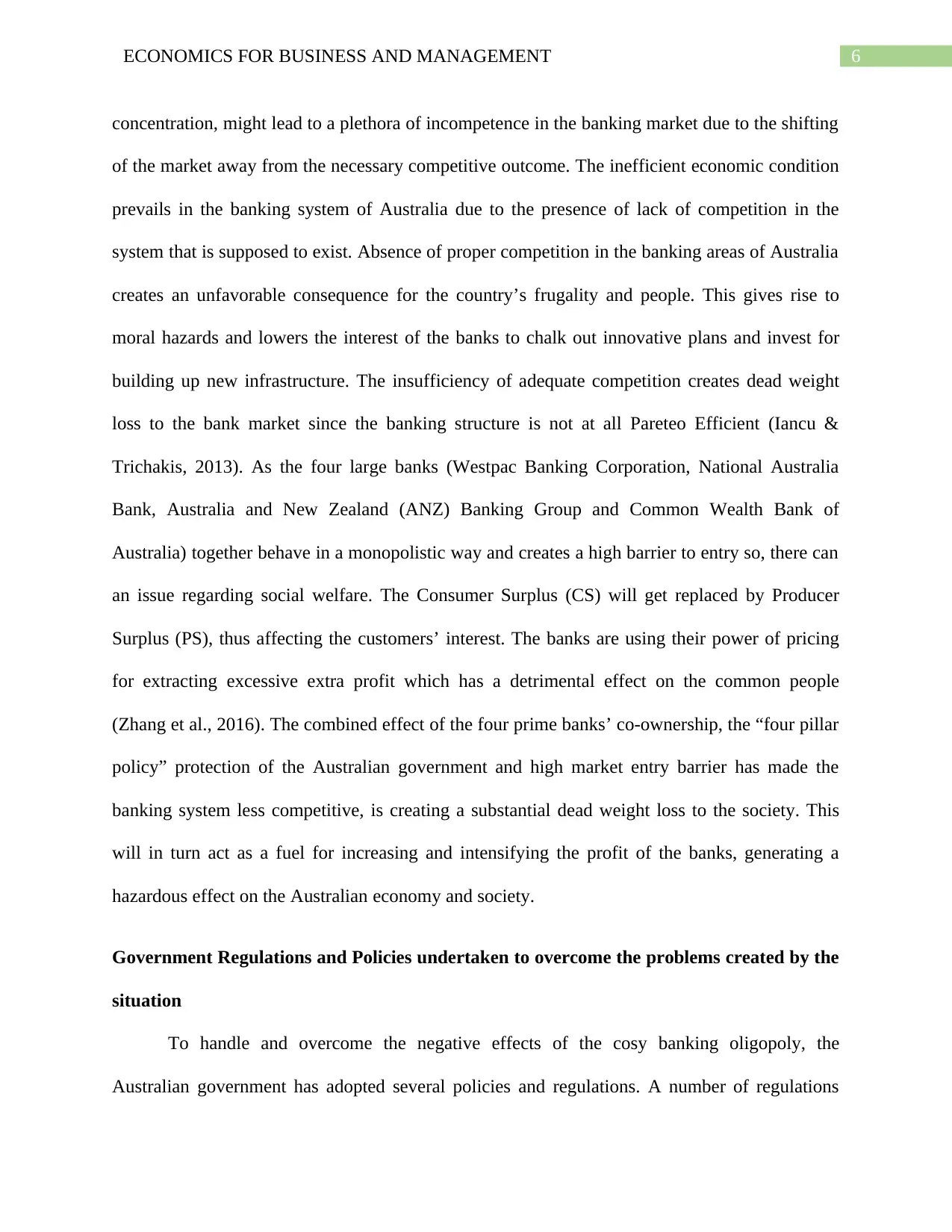
6ECONOMICS FOR BUSINESS AND MANAGEMENT
concentration, might lead to a plethora of incompetence in the banking market due to the shifting
of the market away from the necessary competitive outcome. The inefficient economic condition
prevails in the banking system of Australia due to the presence of lack of competition in the
system that is supposed to exist. Absence of proper competition in the banking areas of Australia
creates an unfavorable consequence for the country’s frugality and people. This gives rise to
moral hazards and lowers the interest of the banks to chalk out innovative plans and invest for
building up new infrastructure. The insufficiency of adequate competition creates dead weight
loss to the bank market since the banking structure is not at all Pareteo Efficient (Iancu &
Trichakis, 2013). As the four large banks (Westpac Banking Corporation, National Australia
Bank, Australia and New Zealand (ANZ) Banking Group and Common Wealth Bank of
Australia) together behave in a monopolistic way and creates a high barrier to entry so, there can
an issue regarding social welfare. The Consumer Surplus (CS) will get replaced by Producer
Surplus (PS), thus affecting the customers’ interest. The banks are using their power of pricing
for extracting excessive extra profit which has a detrimental effect on the common people
(Zhang et al., 2016). The combined effect of the four prime banks’ co-ownership, the “four pillar
policy” protection of the Australian government and high market entry barrier has made the
banking system less competitive, is creating a substantial dead weight loss to the society. This
will in turn act as a fuel for increasing and intensifying the profit of the banks, generating a
hazardous effect on the Australian economy and society.
Government Regulations and Policies undertaken to overcome the problems created by the
situation
To handle and overcome the negative effects of the cosy banking oligopoly, the
Australian government has adopted several policies and regulations. A number of regulations
concentration, might lead to a plethora of incompetence in the banking market due to the shifting
of the market away from the necessary competitive outcome. The inefficient economic condition
prevails in the banking system of Australia due to the presence of lack of competition in the
system that is supposed to exist. Absence of proper competition in the banking areas of Australia
creates an unfavorable consequence for the country’s frugality and people. This gives rise to
moral hazards and lowers the interest of the banks to chalk out innovative plans and invest for
building up new infrastructure. The insufficiency of adequate competition creates dead weight
loss to the bank market since the banking structure is not at all Pareteo Efficient (Iancu &
Trichakis, 2013). As the four large banks (Westpac Banking Corporation, National Australia
Bank, Australia and New Zealand (ANZ) Banking Group and Common Wealth Bank of
Australia) together behave in a monopolistic way and creates a high barrier to entry so, there can
an issue regarding social welfare. The Consumer Surplus (CS) will get replaced by Producer
Surplus (PS), thus affecting the customers’ interest. The banks are using their power of pricing
for extracting excessive extra profit which has a detrimental effect on the common people
(Zhang et al., 2016). The combined effect of the four prime banks’ co-ownership, the “four pillar
policy” protection of the Australian government and high market entry barrier has made the
banking system less competitive, is creating a substantial dead weight loss to the society. This
will in turn act as a fuel for increasing and intensifying the profit of the banks, generating a
hazardous effect on the Australian economy and society.
Government Regulations and Policies undertaken to overcome the problems created by the
situation
To handle and overcome the negative effects of the cosy banking oligopoly, the
Australian government has adopted several policies and regulations. A number of regulations
Paraphrase This Document
Need a fresh take? Get an instant paraphrase of this document with our AI Paraphraser
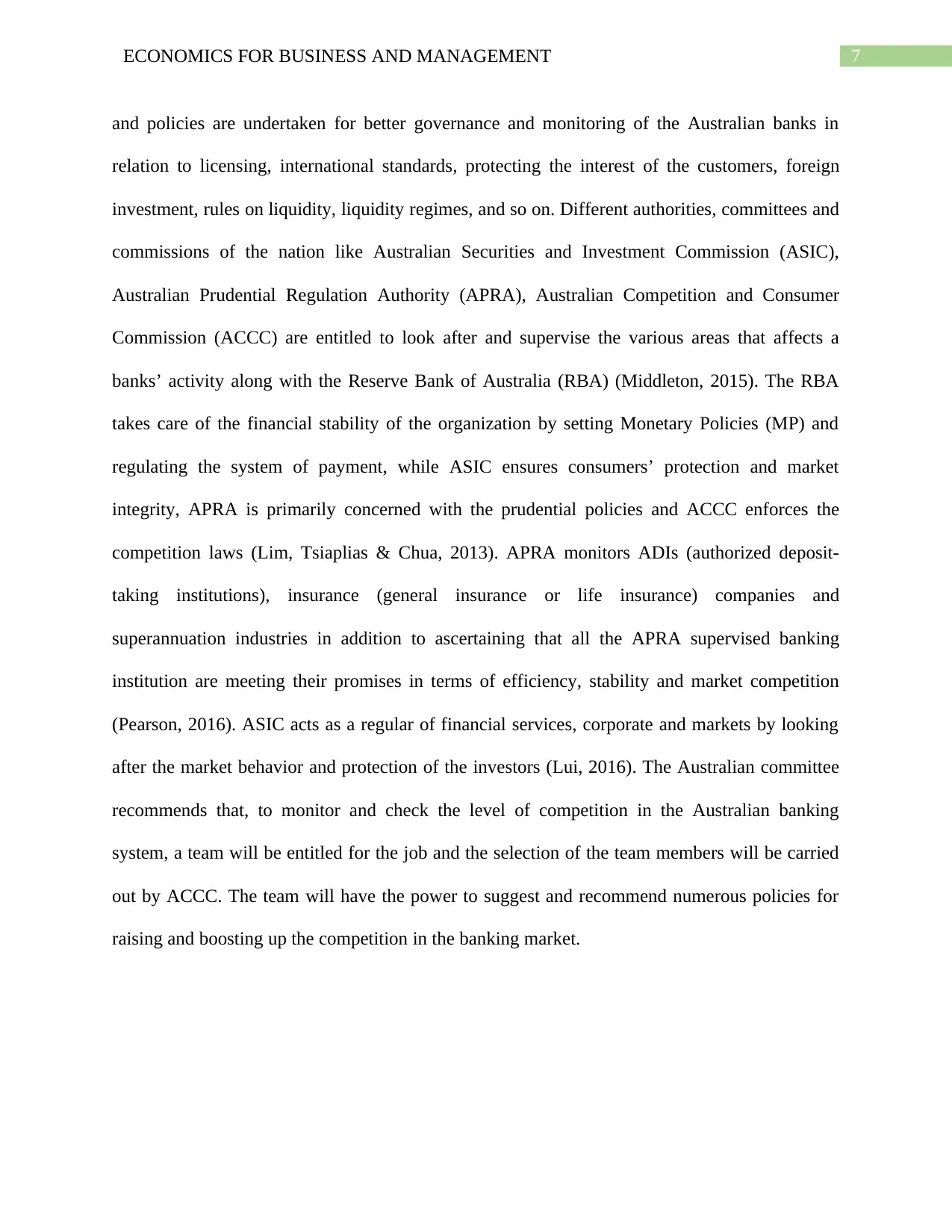
7ECONOMICS FOR BUSINESS AND MANAGEMENT
and policies are undertaken for better governance and monitoring of the Australian banks in
relation to licensing, international standards, protecting the interest of the customers, foreign
investment, rules on liquidity, liquidity regimes, and so on. Different authorities, committees and
commissions of the nation like Australian Securities and Investment Commission (ASIC),
Australian Prudential Regulation Authority (APRA), Australian Competition and Consumer
Commission (ACCC) are entitled to look after and supervise the various areas that affects a
banks’ activity along with the Reserve Bank of Australia (RBA) (Middleton, 2015). The RBA
takes care of the financial stability of the organization by setting Monetary Policies (MP) and
regulating the system of payment, while ASIC ensures consumers’ protection and market
integrity, APRA is primarily concerned with the prudential policies and ACCC enforces the
competition laws (Lim, Tsiaplias & Chua, 2013). APRA monitors ADIs (authorized deposit-
taking institutions), insurance (general insurance or life insurance) companies and
superannuation industries in addition to ascertaining that all the APRA supervised banking
institution are meeting their promises in terms of efficiency, stability and market competition
(Pearson, 2016). ASIC acts as a regular of financial services, corporate and markets by looking
after the market behavior and protection of the investors (Lui, 2016). The Australian committee
recommends that, to monitor and check the level of competition in the Australian banking
system, a team will be entitled for the job and the selection of the team members will be carried
out by ACCC. The team will have the power to suggest and recommend numerous policies for
raising and boosting up the competition in the banking market.
and policies are undertaken for better governance and monitoring of the Australian banks in
relation to licensing, international standards, protecting the interest of the customers, foreign
investment, rules on liquidity, liquidity regimes, and so on. Different authorities, committees and
commissions of the nation like Australian Securities and Investment Commission (ASIC),
Australian Prudential Regulation Authority (APRA), Australian Competition and Consumer
Commission (ACCC) are entitled to look after and supervise the various areas that affects a
banks’ activity along with the Reserve Bank of Australia (RBA) (Middleton, 2015). The RBA
takes care of the financial stability of the organization by setting Monetary Policies (MP) and
regulating the system of payment, while ASIC ensures consumers’ protection and market
integrity, APRA is primarily concerned with the prudential policies and ACCC enforces the
competition laws (Lim, Tsiaplias & Chua, 2013). APRA monitors ADIs (authorized deposit-
taking institutions), insurance (general insurance or life insurance) companies and
superannuation industries in addition to ascertaining that all the APRA supervised banking
institution are meeting their promises in terms of efficiency, stability and market competition
(Pearson, 2016). ASIC acts as a regular of financial services, corporate and markets by looking
after the market behavior and protection of the investors (Lui, 2016). The Australian committee
recommends that, to monitor and check the level of competition in the Australian banking
system, a team will be entitled for the job and the selection of the team members will be carried
out by ACCC. The team will have the power to suggest and recommend numerous policies for
raising and boosting up the competition in the banking market.
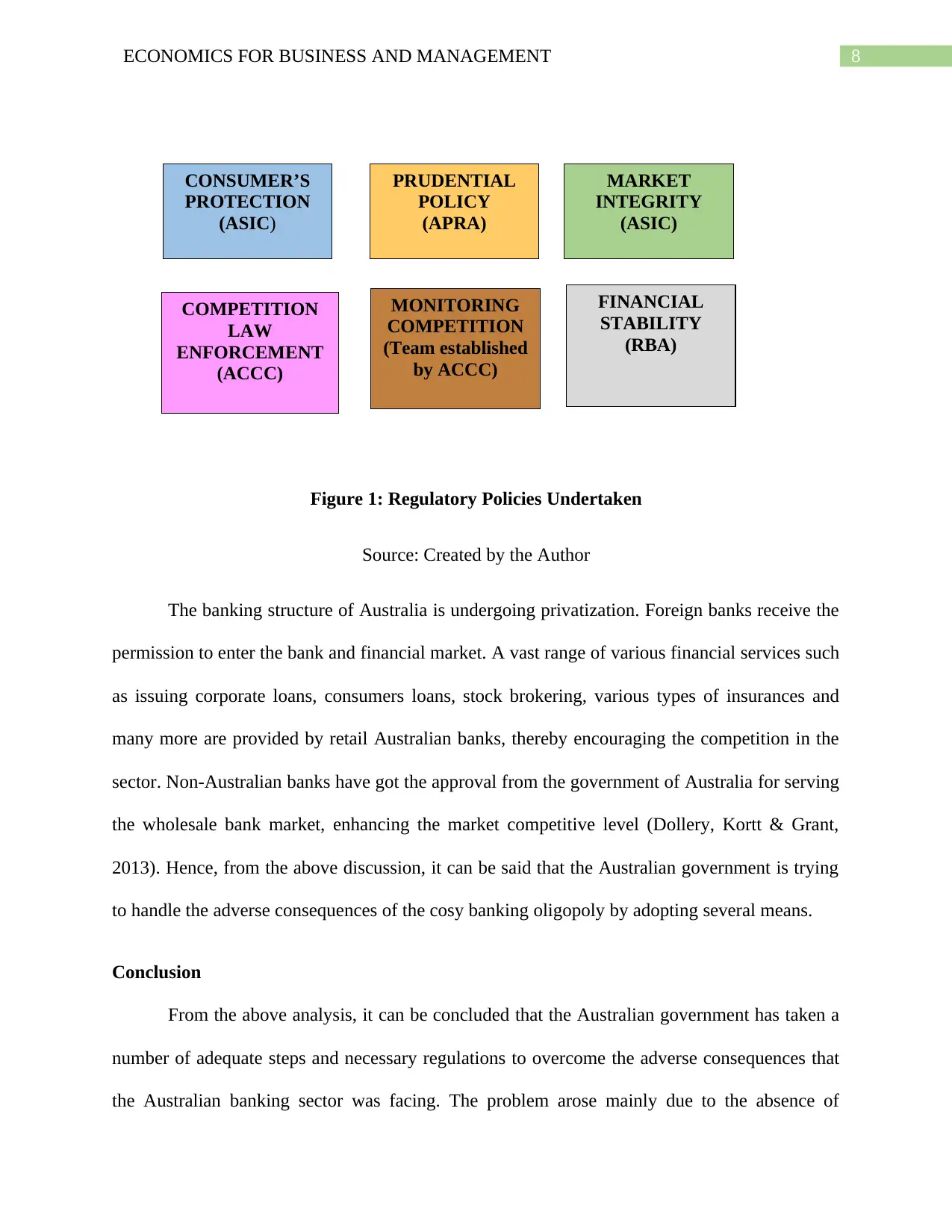
8ECONOMICS FOR BUSINESS AND MANAGEMENT
CONSUMER’S
PROTECTION
(ASIC)
PRUDENTIAL
POLICY
(APRA)
MARKET
INTEGRITY
(ASIC)
COMPETITION
LAW
ENFORCEMENT
(ACCC)
MONITORING
COMPETITION
(Team established
by ACCC)
FINANCIAL
STABILITY
(RBA)
Figure 1: Regulatory Policies Undertaken
Source: Created by the Author
The banking structure of Australia is undergoing privatization. Foreign banks receive the
permission to enter the bank and financial market. A vast range of various financial services such
as issuing corporate loans, consumers loans, stock brokering, various types of insurances and
many more are provided by retail Australian banks, thereby encouraging the competition in the
sector. Non-Australian banks have got the approval from the government of Australia for serving
the wholesale bank market, enhancing the market competitive level (Dollery, Kortt & Grant,
2013). Hence, from the above discussion, it can be said that the Australian government is trying
to handle the adverse consequences of the cosy banking oligopoly by adopting several means.
Conclusion
From the above analysis, it can be concluded that the Australian government has taken a
number of adequate steps and necessary regulations to overcome the adverse consequences that
the Australian banking sector was facing. The problem arose mainly due to the absence of
CONSUMER’S
PROTECTION
(ASIC)
PRUDENTIAL
POLICY
(APRA)
MARKET
INTEGRITY
(ASIC)
COMPETITION
LAW
ENFORCEMENT
(ACCC)
MONITORING
COMPETITION
(Team established
by ACCC)
FINANCIAL
STABILITY
(RBA)
Figure 1: Regulatory Policies Undertaken
Source: Created by the Author
The banking structure of Australia is undergoing privatization. Foreign banks receive the
permission to enter the bank and financial market. A vast range of various financial services such
as issuing corporate loans, consumers loans, stock brokering, various types of insurances and
many more are provided by retail Australian banks, thereby encouraging the competition in the
sector. Non-Australian banks have got the approval from the government of Australia for serving
the wholesale bank market, enhancing the market competitive level (Dollery, Kortt & Grant,
2013). Hence, from the above discussion, it can be said that the Australian government is trying
to handle the adverse consequences of the cosy banking oligopoly by adopting several means.
Conclusion
From the above analysis, it can be concluded that the Australian government has taken a
number of adequate steps and necessary regulations to overcome the adverse consequences that
the Australian banking sector was facing. The problem arose mainly due to the absence of
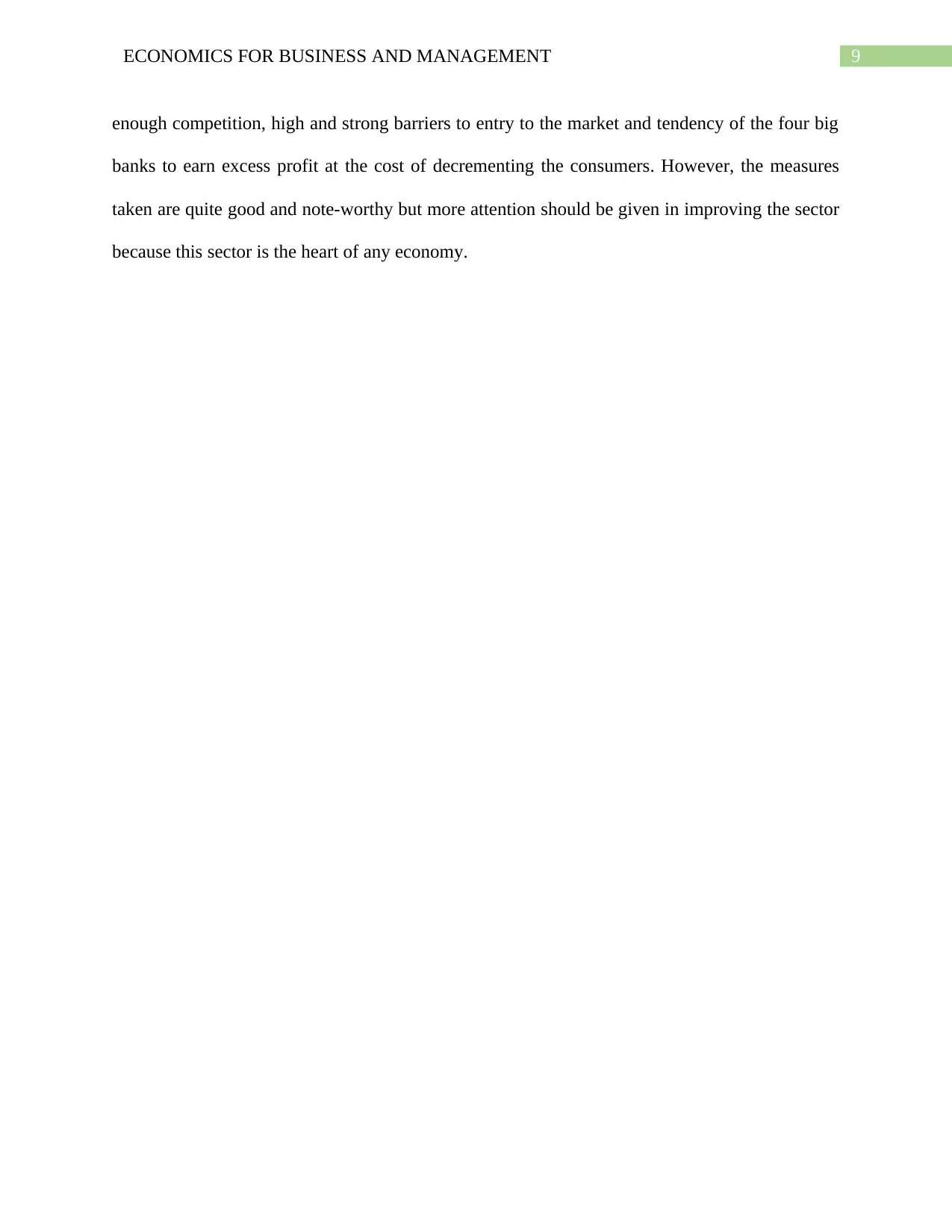
9ECONOMICS FOR BUSINESS AND MANAGEMENT
enough competition, high and strong barriers to entry to the market and tendency of the four big
banks to earn excess profit at the cost of decrementing the consumers. However, the measures
taken are quite good and note-worthy but more attention should be given in improving the sector
because this sector is the heart of any economy.
enough competition, high and strong barriers to entry to the market and tendency of the four big
banks to earn excess profit at the cost of decrementing the consumers. However, the measures
taken are quite good and note-worthy but more attention should be given in improving the sector
because this sector is the heart of any economy.
Secure Best Marks with AI Grader
Need help grading? Try our AI Grader for instant feedback on your assignments.
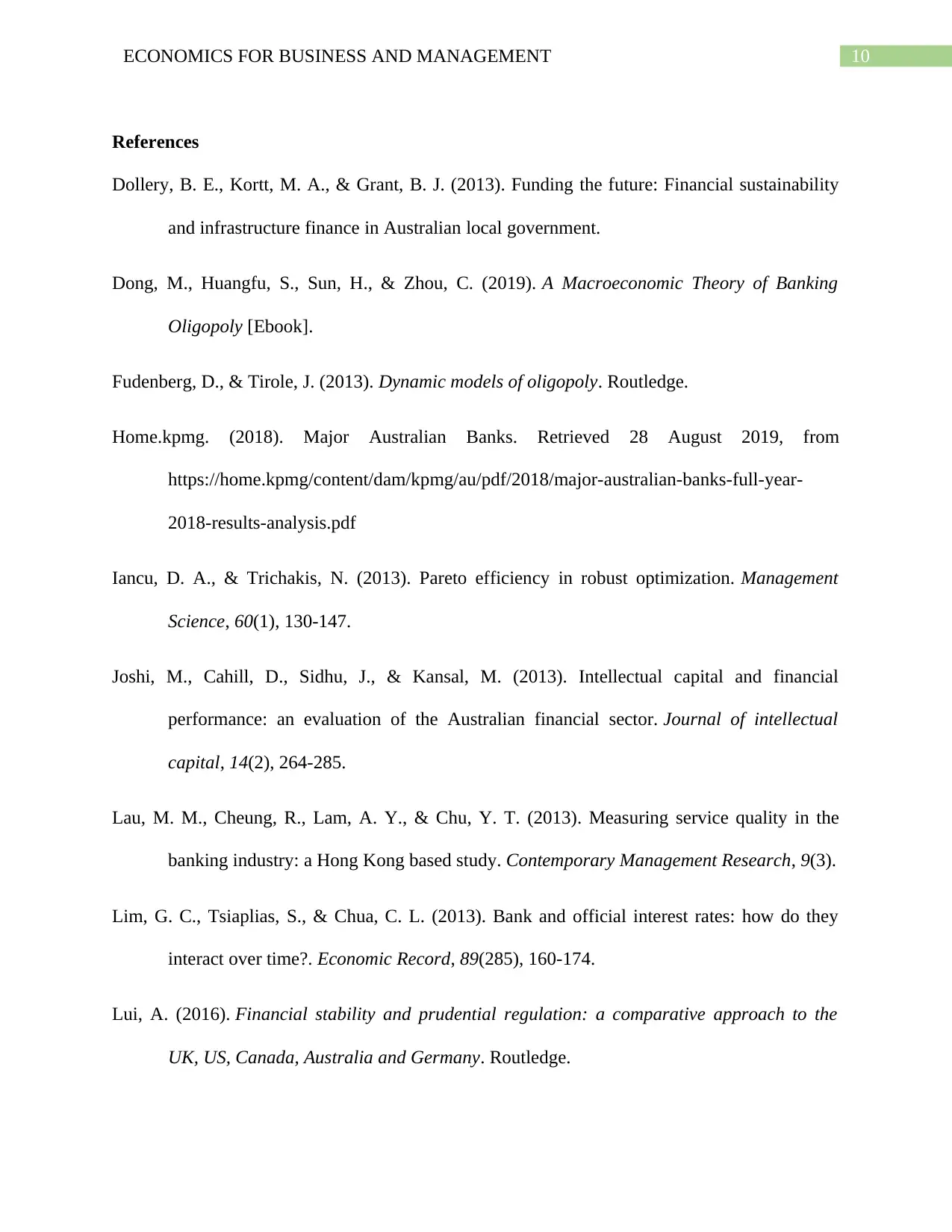
10ECONOMICS FOR BUSINESS AND MANAGEMENT
References
Dollery, B. E., Kortt, M. A., & Grant, B. J. (2013). Funding the future: Financial sustainability
and infrastructure finance in Australian local government.
Dong, M., Huangfu, S., Sun, H., & Zhou, C. (2019). A Macroeconomic Theory of Banking
Oligopoly [Ebook].
Fudenberg, D., & Tirole, J. (2013). Dynamic models of oligopoly. Routledge.
Home.kpmg. (2018). Major Australian Banks. Retrieved 28 August 2019, from
https://home.kpmg/content/dam/kpmg/au/pdf/2018/major-australian-banks-full-year-
2018-results-analysis.pdf
Iancu, D. A., & Trichakis, N. (2013). Pareto efficiency in robust optimization. Management
Science, 60(1), 130-147.
Joshi, M., Cahill, D., Sidhu, J., & Kansal, M. (2013). Intellectual capital and financial
performance: an evaluation of the Australian financial sector. Journal of intellectual
capital, 14(2), 264-285.
Lau, M. M., Cheung, R., Lam, A. Y., & Chu, Y. T. (2013). Measuring service quality in the
banking industry: a Hong Kong based study. Contemporary Management Research, 9(3).
Lim, G. C., Tsiaplias, S., & Chua, C. L. (2013). Bank and official interest rates: how do they
interact over time?. Economic Record, 89(285), 160-174.
Lui, A. (2016). Financial stability and prudential regulation: a comparative approach to the
UK, US, Canada, Australia and Germany. Routledge.
References
Dollery, B. E., Kortt, M. A., & Grant, B. J. (2013). Funding the future: Financial sustainability
and infrastructure finance in Australian local government.
Dong, M., Huangfu, S., Sun, H., & Zhou, C. (2019). A Macroeconomic Theory of Banking
Oligopoly [Ebook].
Fudenberg, D., & Tirole, J. (2013). Dynamic models of oligopoly. Routledge.
Home.kpmg. (2018). Major Australian Banks. Retrieved 28 August 2019, from
https://home.kpmg/content/dam/kpmg/au/pdf/2018/major-australian-banks-full-year-
2018-results-analysis.pdf
Iancu, D. A., & Trichakis, N. (2013). Pareto efficiency in robust optimization. Management
Science, 60(1), 130-147.
Joshi, M., Cahill, D., Sidhu, J., & Kansal, M. (2013). Intellectual capital and financial
performance: an evaluation of the Australian financial sector. Journal of intellectual
capital, 14(2), 264-285.
Lau, M. M., Cheung, R., Lam, A. Y., & Chu, Y. T. (2013). Measuring service quality in the
banking industry: a Hong Kong based study. Contemporary Management Research, 9(3).
Lim, G. C., Tsiaplias, S., & Chua, C. L. (2013). Bank and official interest rates: how do they
interact over time?. Economic Record, 89(285), 160-174.
Lui, A. (2016). Financial stability and prudential regulation: a comparative approach to the
UK, US, Canada, Australia and Germany. Routledge.

11ECONOMICS FOR BUSINESS AND MANAGEMENT
Middleton, T. (2015). Banning, disqualification and licensing powers: ACCC, APRA, ASIC and
the ATO–regulatory overlap, penalty privilege and law reform. Company and Securities
Law Journal, 33, 555-580.
Moradi-Motlagh, A., & Babacan, A. (2015). The impact of the global financial crisis on the
efficiency of Australian banks. Economic Modelling, 46, 397-406.
Pearson, G. (2016). Financial literacy and the creation of financial citizens. In The Future of
Consumer Credit Regulation (pp. 21-46). Routledge.
Salim, R., Arjomandi, A., & Seufert, J. H. (2016). Does corporate governance affect Australian
banks' performance?. Journal of International Financial Markets, Institutions and
Money, 43, 113-125.
Twigg, P. (2018). A Theory & Evidence Based Assessment of Competition in the Australian
Banking System [Ebook].
Waldman, D. E., & Jensen, E. J. (2016). Industrial organization: theory and practice. Routledge.
Zhang, Y., Zhao, Q., Zhang, Y., Friedman, D., Zhang, M., Liu, Y., & Ma, S. (2016, April).
Economic recommendation with surplus maximization. In Proceedings of the 25th
International Conference on World Wide Web (pp. 73-83). International World Wide
Web Conferences Steering Committee.
Middleton, T. (2015). Banning, disqualification and licensing powers: ACCC, APRA, ASIC and
the ATO–regulatory overlap, penalty privilege and law reform. Company and Securities
Law Journal, 33, 555-580.
Moradi-Motlagh, A., & Babacan, A. (2015). The impact of the global financial crisis on the
efficiency of Australian banks. Economic Modelling, 46, 397-406.
Pearson, G. (2016). Financial literacy and the creation of financial citizens. In The Future of
Consumer Credit Regulation (pp. 21-46). Routledge.
Salim, R., Arjomandi, A., & Seufert, J. H. (2016). Does corporate governance affect Australian
banks' performance?. Journal of International Financial Markets, Institutions and
Money, 43, 113-125.
Twigg, P. (2018). A Theory & Evidence Based Assessment of Competition in the Australian
Banking System [Ebook].
Waldman, D. E., & Jensen, E. J. (2016). Industrial organization: theory and practice. Routledge.
Zhang, Y., Zhao, Q., Zhang, Y., Friedman, D., Zhang, M., Liu, Y., & Ma, S. (2016, April).
Economic recommendation with surplus maximization. In Proceedings of the 25th
International Conference on World Wide Web (pp. 73-83). International World Wide
Web Conferences Steering Committee.
1 out of 12
Related Documents
Your All-in-One AI-Powered Toolkit for Academic Success.
+13062052269
info@desklib.com
Available 24*7 on WhatsApp / Email
![[object Object]](/_next/static/media/star-bottom.7253800d.svg)
Unlock your academic potential
© 2024 | Zucol Services PVT LTD | All rights reserved.





